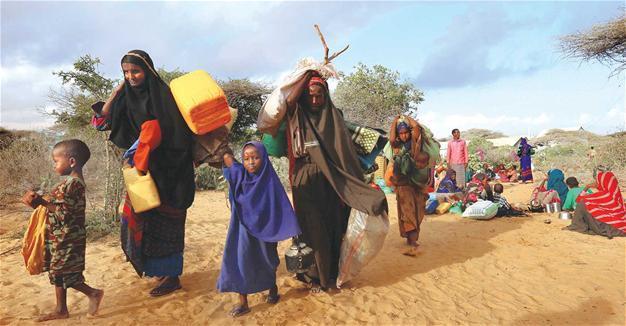Cloaked in rags and dust, Somalis flee looming famine
BAIDOA, Somalia - Agence France Presse
 Mariam Ibrahim, her seven children and two neighboring families were the last to leave their village in southwestern Somalia.
Mariam Ibrahim, her seven children and two neighboring families were the last to leave their village in southwestern Somalia.They loaded their combined belongings - blankets, cooking pots, sleeping mats, jerry cans, clothes - onto a hired donkey cart and walked beside it for 20 kilometers to Baidoa, the closest city.
“There is nobody left now,” said the 28-year-old.
She joined thousands of others who are arriving in Baidoa each day, staggering from the parched countryside into the garrison city, cloaked in rags and dust.
Clusters of stick and cloth domes are appearing across the outskirts of Somalia’s regional capital.
Somali and Ethiopian soldiers - part of an African Union force - secure the town against the al-Qaeda-aligned al-Shabaab militants whose control begins just 15 kilometers away.
Successive seasons of poor rains and failed harvests have left farming families like Ibrahim’s destitute and on the brink of famine.
The United Nations is warning of an unprecedented global crisis with famine already gripping parts of South Sudan and looming over Nigeria, Yemen and Somalia, threatening the lives of 20 million people.
For Somalis, the memory of the 2011 famine which left a quarter of a million people dead is still fresh.
But Ibrahim said what is happening now feels worse.
First the food ran out, then the wells emptied.
And the little water that remains is brackish or diseased. So when her village of Aliyow Mumin suffered an outbreak of cholera in late January, Ibrahim decided to leave.
Muslima Kusow was born into famine 25 years ago and survived 2011, but it was this year’s drought which forced her to abandon her home for the first time.
She left the farming village of Roobey in early March, trekking four days northwards with her six children to Baidoa.
Asked why, Kusow feathers four slender fingers down her throat to mime swallowing, then holds out an empty hand: “Thirst. Hunger.”
Her youngest child, two-year-old Asiba, is skinny and pale, lacking the strength to hold her head upright.
At the Deeg-Roor Medical Organisation - the name means “first rains” - Abdirahim Mohamed says new outpatients are registering for the UNICEF-backed feeding program at an exponential rate.
In February, 75 children were admitted to the clinic, more than double the number in January and a figure he predicts will double again in March.
The worst cases - youngsters too weak to feed, or those suffering from outbreaks of cholera that have killed 286 and infected over 11,000 nationwide this year - are taken to the city hospital.
Inside, cholera patients lie on blankets on the concrete floor or on metal bed frames, attached to intravenous drips.
Tuk-tuks race in disgorging new victims. Visitors are sprayed with chlorine on the way out.
In the intensive care unit of the hospital’s malnutrition center, nine beds are tightly packed into a hot, dim room. All but one are occupied by mothers with their slowly recovering children.
Hamsia Ibrahim, 32, swirls breast milk in a plastic bowl before trickling it into a syringe and feeding it, through a nasal tube, into the stomach of her seven-month-old daughter Shamso.
Her husband and five other children stay in a makeshift camp for the recently uprooted where they arrived last month.
“My other children are hungry all the time, but they are not sick like this,” she said of Shamso, whose diarrhea and vomiting caused her weight to plummet.
She said a local businessman handed out cooked food at the camp a week ago: “That was the last time we had three meals in a day.”
The growth of the camps is accelerating. There are 133 of the settlements, expanding towards one another across the barren, rocky land. The U.N. records new arrivals by the household and says 2,929 arrived in the first week of March. The figure for the whole of February was 3,967.
The average household is estimated to number six people meaning roughly 2,500 people are arriving in Baidoa every day.
By mid-afternoon in the camps, the temperature tilts towards 40 degrees, the hot wind conjures dust devils and the thorny trees provide little shade.
















